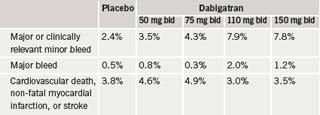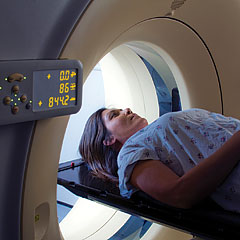Highlights from the recent American Heart Association meeting held in Orlando, Florida, USA, from 14th–18th November 2009, included good news for niacin but not for ezetimibe in atherosclerosis, more promising results for dabigatran in acute coronary syndromes, and warnings that the benefits of eating fish depend on how it is cooked.
ARBITER 6: niacin superior to ezetimibe for slowing atherosclerosis
Use of extended-release niacin resulted in a significant benefit on atherosclerosis compared with ezetimibe in patients already taking statins in the ARBITER 6-HALTS trial.
The trial, presented at the meeting by Dr Allen Taylor (Medstar Research Institute, Washington DC, US), compared two distinct lipid-modifying strategies in patients with known vascular disease already on statins who had LDL-cholesterol levels <100 mg/dL (2.56 mmol/L) and moderately low HDL-cholesterol levels (<50 mg/dL [1.28 mmol/L]). Among the 363 patients enrolled in the study, half were randomised to a treatment that further reduced LDL-cholesterol levels with the addition of ezetimibe (10 mg/daily) to statin therapy, while the other half were randomised to HDL-raising therapy with extended-release niacin (2,000 mg/daily).
During the 14 months of treatment, mean HDL-cholesterol levels among the niacin-treated patients increased 18.4%, while in the ezetimibe arm, LDL-cholesterol levels further declined by 19.2%.
Compared with ezetimibe, treatment with niacin resulted in significantly larger changes in the mean and maximal carotid intimal media thickness (IMT) over 14 months. From baseline, niacin resulted in a significant regression of mean and maximal carotid IMT when measured at eight months and 14 months, whereas there was no significant change in mean or maximal IMT among those treated with ezetimibe. Although not powered for clinical outcomes, there were more major cardiovascular events in the ezetimibe arm compared with those in the niacin arm (nine events vs. two events, respectively; p=0.04).
Dr Taylor said the findings answer an important clinical question in secondary prevention. “If my patient is on a statin, then where do I go from here?” he said. “These results suggest that niacin is superior in a head-to-head trial with ezetimibe.”
The ARBITER results were also published in the New England Journal of Medicine (2009;361:2113–22) to correspond with their presentation at the AHA meeting.
In an accompanying editorial (pages 2178–80), Drs Roger Blumenthal and Erin Michos (Johns Hopkins University, Baltimore, US) say they “support the use of niacin as the preferred adjunctive agent to be used in combination with the maximal dose of a potent statin in persons who have low levels of HDL cholesterol and established cardiovascular disease”.
A second editorial (pages 2180–3) by Drs John Kastelein (Academic Medical Center, Amsterdam, the Netherlands) and Michel Bots (University Medical Center, Utrecht, the Netherlands) points out that the magnitude of difference in ARBITER may have been exaggerated somewhat because the trial was stopped early. But they still believe the results to be correct. “Together, the results available to date provide support for the concept that the use of statins to reduce LDL to target levels with the subsequent addition of a drug to raise HDL-cholesterol levels (niacin), rather than a drug to lower LDL-cholesterol levels (ezetimibe), is a more effective treatment for patients at high cardiovascular risk,” they conclude.
NIA Plaque: no benefit of niacin in patients at goal on statins
A second study of niacin presented at the meeting did not show such good results for the drug.
In the NIA Plaque trial, addition of niacin to statin therapy in secondary prevention patients resulted in improvements in both LDL and HDL cholesterol levels but did not significantly alter atherosclerotic disease progression compared with statin therapy alone.
Lead researcher Dr Christopher Sibley (Johns Hopkins University Medical Center, US) suggested that the different results of NIA Plaque and ARBITER-6 were due to differences in the patients enrolled. The most important difference, he said, was the baseline levels of HDL, which were higher in NIA Plaque (mean 55 mg/dL [1.41 mmol/L]) compared with ARBITER-6 (42 mg/dL [1.08 mmol/L]). While ARBITER suggests niacin is beneficial in patients with lower levels of HDL, NIA Plaque shows no additional benefit over optimal statin therapy in the more general population, he added.
In the NIA study, 145 patients with clinically evident atherosclerosis were randomised to 1,500 mg daily of extended-release niacin or to placebo. All patients were treated with a statin as needed to reach LDL-cholesterol targets. After 18 months of follow-up, extended-release niacin resulted in significant increases in HDL cholesterol and a significant decrease in LDL cholesterol. Statins alone resulted in significant reductions in LDL cholesterol but did not positively affect HDL-cholesterol levels.
The primary end point of the study – change in the internal carotid artery wall volume – was not different between groups, with both treatments showing significant reductions from baseline.
How fish is cooked affects cardiovascular benefits
 It is well known that omega-3 fatty acids found in fish have cardiovascular benefits, but new research shows that how the fish is cooked is also important.
It is well known that omega-3 fatty acids found in fish have cardiovascular benefits, but new research shows that how the fish is cooked is also important.
A study by researchers from the University of Hawaii at Manoa, Honolulu, Hawaii, US, showed that baked or boiled fish is associated with more benefit from omega-3 fatty acids than fried, salted or dried fish. It also found that eating fish with low-sodium soy sauce or tofu will enhance the benefits.
In addition, the findings suggest that the cardioprotective benefits vary by gender and ethnicity, due perhaps to the preparation methods, genetic susceptibility or hormonal factors. Specifically, it showed that Caucasian, Japanese-American and Latino men may be more likely to get the health benefits of fish than African-American or Hawaiian men, and that omega-3s from plant sources, such as soy, may do more to improve women’s heart health than fish sources.
“It appears that boiling or baking fish with low-sodium soy sauce (shoyu) and tofu is beneficial, while eating fried, salted or dried fish is not,” said lead researcher, Ms Lixin Meng.
In the study, researchers examined the source, type, amount and frequency of dietary omega-3 ingestion among 82,243 men and 103,884 women of African-American, Caucasian, Japanese, Native Hawaiian and Latino descent ages 45 to 75 years old with no history of heart disease.
They found that those in the highest quintile of omega-3 intake consumed a median 3.3 g a day, while those in the lowest quintile consumed a median of 0.8 g a day.
During the average 11.9 years of follow-up, 4,516 heart-related deaths occurred in the group, according to state and national death records, which were cross-referenced through the end of 2005.
Results showed that omega-3 intake was inversely associated with overall risk of death due to heart disease in men – a trend mainly observed in Caucasians, Japanese Americans and Latinos. However, there weren’t many blacks or Hawaiians in the study, so the results should be interpreted cautiously, Ms Meng said. Overall, men who ate about 3.3 g per day of omega-3 fatty acids had a 23% lower risk of cardiac death compared to those who ate 0.8 g daily.
For women, the omega-3 effect was cardioprotective at each level of consumption but not consistently significant, Ms Meng said. Salted and dried fish was a risk factor for heart disease in women. In contrast, adding less than 1.1 g/day shoyu and teriyaki sauce at the dinner table was protective for men but not for greater than 1.1 g/day. For women, shoyu use showed a clear inverse relationship to death from heart disease. She noted that shoyu that is high in sodium can raise blood pressure, so she stressed low-sodium products. Eating tofu also had a cardioprotective effect in all ethnic groups.
Cholesterol and smoking rates improving but obesity increasing
Although some risk factors for heart disease, such as cholesterol and smoking, have seen impressive reductions over the past two decades, any benefits are probably being wiped out by increasing levels of obesity.
This is the conclusion of a new analysis of data from the US National Health and Nutrition Examination Survey (NHANES). The study included 8,264 adult men and women, 20 to 85 years old who had undergone risk factor screening for blood pressure, fasting glucose, low-density lipoprotein (LDL) cholesterol and smoking status in 1988 and again in 2006.
Researchers led by Dr Kami Banks (University of Texas Southwestern Medical Center, Dallas, US) found that during this time period, the average body mass index (BMI) increased from 26.5 to 28.8 kg/m2, a significant change. In addition, the number of people with optimal blood pressure decreased from 48% to 43%, and the number with optimal fasting glucose decreased from 67% to 58%. Dr Banks noted that blood pressure and blood glucose are closely linked to obesity and these adverse trends track with the change in body weight.
More positive trends were seen for LDL cholesterol, with optimal levels reported in 22% of the population in 1998 increasing to 28% in 2006, and smoking which was reduced from 55% to 50%.
“Despite focused public health efforts, there is no net improvement in the overall cardiovascular risk factor profile over the past two decades in the US population”, Dr Banks said. “Lifestyle changes and physical activity are key. As physicians we need to prescribe prevention – writing exercise prescriptions and healthy dietary prescriptions just like we prescribe medication,” she added.
Playing active video games can equal moderate-intensity exercise
 Playing active video games such as Wii sport and Wii fit can provide energy expenditures equal to moderate-intensity exercise, according to a new study, sponsored by Nintendo, the maker of the Wii.
Playing active video games such as Wii sport and Wii fit can provide energy expenditures equal to moderate-intensity exercise, according to a new study, sponsored by Nintendo, the maker of the Wii.
The study found that about one-third of the virtual physical activities in the games require an energy expenditure of 3.0 METs or above, considered moderate-intensity exercise. METs are metabolic equivalent values, a standard method of estimating energy expenditure.
Researchers used a metabolic chamber to measure the energy expenditure of 12 men and women, 25 to 44 years old, as they engaged in the basic moves involved in the games. They found that nine of the activities had less than 2 METs, 23 activities had 2–3 METs, nine had 3–4 METs, and five activities had more than 4 METs.
In the Wii sports package, boxing was the most effective activity to increase energy expenditure, at about 4.5 METs. Golf had a score of 2 METs, bowling 2.6 METs, and tennis and baseball were both associated with 3 METs.
According to the American Heart Association’s exercise guidelines, light intensity exercise is less than 3 METs; moderate intensity is 3 to 6 METs; and vigorous activity is more than 6 METs. An adult walking at three miles per hour on a flat surface is expending about 3.3 METs. Adults gain the most health benefits when they do the equivalent of at least 150 minutes (2 ½ hours) of moderate intensity aerobic physical activity each week.
Postmortem gene tests after sudden death recommended
Targeted postmortem testing to identify genetic mutations associated with sudden unexplained death is an effective and less expensive way to determine risk to relatives than comprehensive cardiac testing,
according to new research.
Dr Michael Ackerman (Mayo Clinic, Rochester, US) explained that postmortem genetic testing can identify mutations that cause cellular dysfunctions leading to heart rhythm disturbances, and such genetic defects occur in 25-30% of sudden unexplained death victims.
In his study, Dr Ackerman and colleagues compared the yield and costs of postmortem genetic/molecular autopsy testing in 146 cases of sudden unexplained death. They found that 40 of the victims (26.7%) had either a catecholaminergic polymorphic ventricular tachycardia (CPVT) mutation (18) or a long QT syndrome mutation (22), both known contributors to sudden death.
They estimated that the total cost of both doing postmortem genetic testing, genetic confirmation testing of relatives of mutation-positive victims, followed by cardiac tests for both relatives of mutation-positive and mutation-negative sudden unexplained death (SUD) victims, was US$ 6.78 million.
In contrast, the total cost associated with what is currently recommended – comprehensive cardiac testing for all 584 relatives of the SUD victims, regardless of mutation status, followed by directed genetic testing – would have exceeded US$ 7.7 million.
“If you identify a mutation in a sudden unexplained death victim, you can do a simple genetic test in first-degree relatives to assess their risk and perform a disorder-directed clinical evaluation rather than a full clinical evaluation. If a relative is negative for the causative mutation, they may not need to undergo further clinical evaluation at all, and that saves money”, Dr Ackerman said.
Early cooling in cardiac arrest may improve survival
Rapidly cooling a person in cardiac arrest may improve their chance of survival without brain damage, according to a new study.
In the PRINCE (Pre-Resuscitation Intra-Nasal Cooling Effectiveness) investigation, researchers led by Dr Maaret Castrén (Karolinska Institute, Stockholm, Sweden) used a new tool, RhinoChill, that cools the brain during ongoing cardiopulmonary resuscitation (CPR) by introducing coolant through nasal prongs. The system is battery-powered and requires no refrigeration, making it suitable for emergency medical technicians in the field to use while a person is receiving CPR.
They randomised 182 adults who suffered a witnessed cardiac arrest to receive either standard resuscitation or resuscitation with the RhinoChill cooling device started as soon as possible during the arrest. All patients who survived to hospitalisation were further cooled according to standard criteria.
The patients in each group were similar in their initial heart rhythms, how much time lapsed before CPR was started and whether CPR restored a pulse. The median time between arrest and the initiation of cooling was 23 minutes. On arrival at the hospital, the cooled patients’ temperatures were significantly lower (average 34.2ºC) than those receiving standard care (35.5ºC).
Results showed that 46.7% of those cooled survived to hospital discharge, compared with 31% of those receiving standard care. In addition, 36.7% of those cooled were in good neurological condition on hospital discharge, compared with 21.4% of those receiving standard care.
The best results were seen in those in whom resuscitation efforts began within 10 minutes of cardiac arrest. “Our results show that the earlier you can do the cooling, the better,” Dr Castrén said. “When resuscitation efforts were delayed, there was no significant difference in survival.”
RhinoChill has been approved for marketing in Europe and is expected to become available during 2010.
Dabigatran appears safe with aspirin plus clopidogrel in
ACS patients
The new oral anticoagulant, dabigatran, appears to be safe when combined with aspirin and clopidogrel in acute coronary syndrome (ACS) patients, according to the results of the REDEEM trial.
Doses ranging from 50 mg twice daily to 150 mg twice daily were all associated with six-month rates of “major and clinically relevant minor bleeds” of less than 8%, which the lead investigator, Dr Jonas Oldgren (Uppsala University Hospital, Sweden) described as “acceptable”.
The trial enrolled 1,861 patients with ST elevation myocardial infarction (STEMI) or non-STEMI and at least one additional cardiovascular risk factor, such as prior myocardial infarction (MI), diabetes or heart failure. They were already taking aspirin and clopidogrel and about half had undergone percutaneous coronary intervention. They were randomised to placebo or dabigatran at one of the four doses starting a mean of 7 days after the acute event and continuing for six months.
The primary end point was major bleeding or clinically relevant minor bleeding at six months (see table 1).

Designated discussant of the trial, Dr Elaine Hylek (Boston University, US) said the major haemorrhage rates with this triple anticoagulant therapy were “acceptably low”, but she added that the minor bleeding risk should not be overlooked as it is often these bleeds that make patients discontinue therapy.
The two highest dosages in the REDEEM study, 110 mg twice daily and 150 mg twice daily, have already shown good results versus warfarin in atrial fibrillation patients in the RELY trial.
PLATO: ticagrelor shows superiority to clopidogrel
Data from a subanalysis of the phase III PLATO (PLATelet inhibition and patient Outcomes) study presented at the meeting showed that the new antiplatelet agent, ticagrelor, a direct acting oral P2Y12-receptor antagonist, was superior
to the thienopyridine, clopidogrel, in ST elevation myocardial infarction (STEMI) patients who require percutaneous coronary intervention treatment. The agent also showed no increased risk of overall major bleeding.
The pre-specified sub-analysis included approximately 45% of the overall PLATO study population (8,430). Results show that, compared to clopidogrel, treatment with ticagrelor resulted in a reduction of cardiovascular (CV) events (composite of CV death, myocardial infarction [MI] and stroke) for up to a year (ticagrelor vs. clopidogrel 9.3% vs. 11%, p=0.02, HR 0.85 [0.74–0.97]), without an increase in major bleeding (9% vs. 9.3%, p=0.63). These efficacy findings were driven by a statistically significant reduction in MI (4.7% vs. 6.1%, p=0.01).
Ticagrelor also demonstrated effects across several secondary efficacy end points including MI, stent thrombosis, and the composite of MI, stroke and all-cause mortality. There was an 18% relative reduction in all-cause mortality at one year from 6.0 to 4.9% (P=0.04) with ticagrelor over clopidogrel.
Pharmokinetic data with ticagrelor from patients with stable coronary artery disease presented at a later session at the meeting showed that ticagrelor had a faster onset and offset of action than clopidogrel. Unlike the thienopyridines, ticagrelor is a reversible agent. A possible drawback over clopidogrel, however, could be the twice-daily dosing ticagrelor requires.
Results in ACS
A further analysis of PLATO published online in the Lancet on 14th January 2010 has shown that ticagrelor seems to be a better option than clopidogrel for patients with acute coronary syndromes (with and without ST elevation) for whom early invasive strategy is planned.
RAPTOR shows advantages of radial access for cardiac procedures
Changing from femoral artery access to radial artery access for interventional cardiac procedures can be done without affecting patient safety, and leads to more economic use of hospital resources, the RAPTOR study suggests.
Presenting the study, Dr Tim Günter Schäufele (Heart Institute, Lahr, Germany) explained that the RAPTOR trial was designed to determine whether operators experienced in femoral access could switch to radial access as a routine strategy in a real-world population and if this switch affected patient safety, radiation exposure, patient comfort, procedural durations, and staff involvement. Over a one-year period, 410 patients at a single, high-volume German centre were randomised to femoral- or radial-access intervention and, of these, approximately 75% underwent diagnostic intervention and 25% underwent percutaneous coronary intervention (PCI).
Results showed that both procedural times and radiation doses were increased with the radial approach for angiography patients, but were similar with the two approaches in patients undergoing PCI. One of the main advantages of radial access is less bleeding, leading to a much reduced compression time of the access site, and quicker ambulation of the patient. In this study, compression time was reduced from about 12 minutes in patients treated with the conventional femoral approach to almost zero for patients treated via the radial artery. This led to an overall ‘time savings’ for staff with each procedure – in a high-volume centre performing 3,000 procedures annually, including 1,000 PCIs, there could be a time saving of 1,300 hours of staff involvement, Dr Schäufele reported.
MI patients receiving high radiation dose
 Myocardial infarction (MI) patients receive an average total dose of ionising radiation equal to 725 chest X-rays from medical tests during their hospital stay, according to the first large study to examine this issue.
Myocardial infarction (MI) patients receive an average total dose of ionising radiation equal to 725 chest X-rays from medical tests during their hospital stay, according to the first large study to examine this issue.
Data from 64,074 MI patients between 2006 and 2009 at 49 academic hospitals in the US were analysed. Results showed that those admitted to academic hospitals had a cumulative effective radiation dose of 14.5 millisieverts (mSv) – about one-third the annual maximum accumulation permitted for workers in nuclear power plants and other ionising radiation environments.
Lead author, Dr Prashant Kaul (Duke University Medical Center, Durham, US) said: “We think physicians should have a greater awareness of radiation dose accumulation from the tests they are ordering”.
Physicians perform several billion imaging studies annually worldwide, about one-third of them in cardiovascular patients. The collective dose received annually from ionising radiation medical tests increased by an estimated 700% between 1980 and 2006, according to the American Heart Association.
“We should not withhold necessary, appropriate tests that involve ionising radiation – they provide very important information,” Dr Kaul said. “What we should do is evaluate and understand the clinical indications for tests that involve ionising radiation. We need to be sure they are being done appropriately.”
He added: “Physicians tend to focus on the radiation dose of each procedure rather than the cumulative dose a patient will receive. This makes the risk seem smaller to patients than it actually is. The risk at an individual level is small with one test, but with multiple tests the risk likely increases”.
